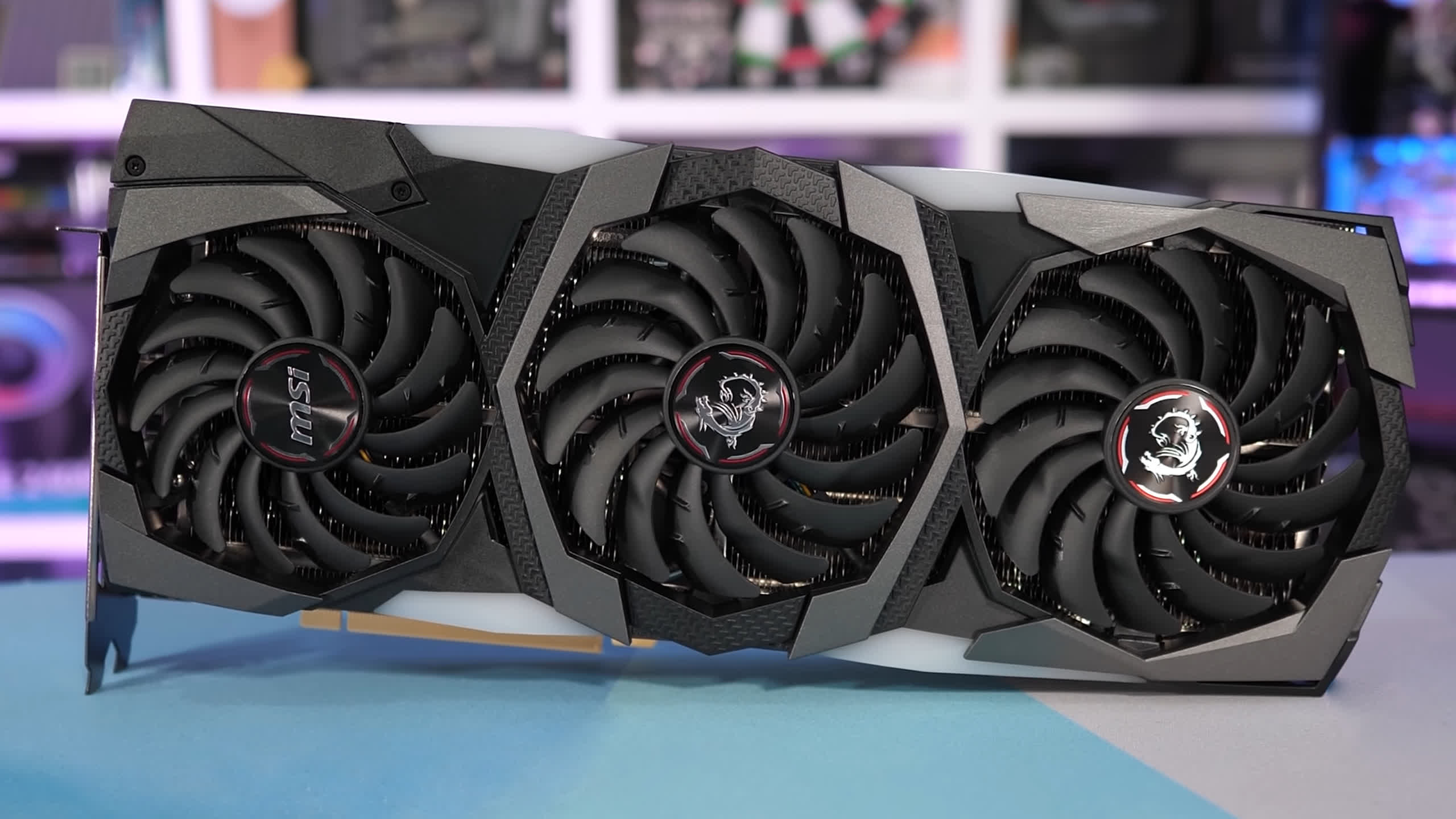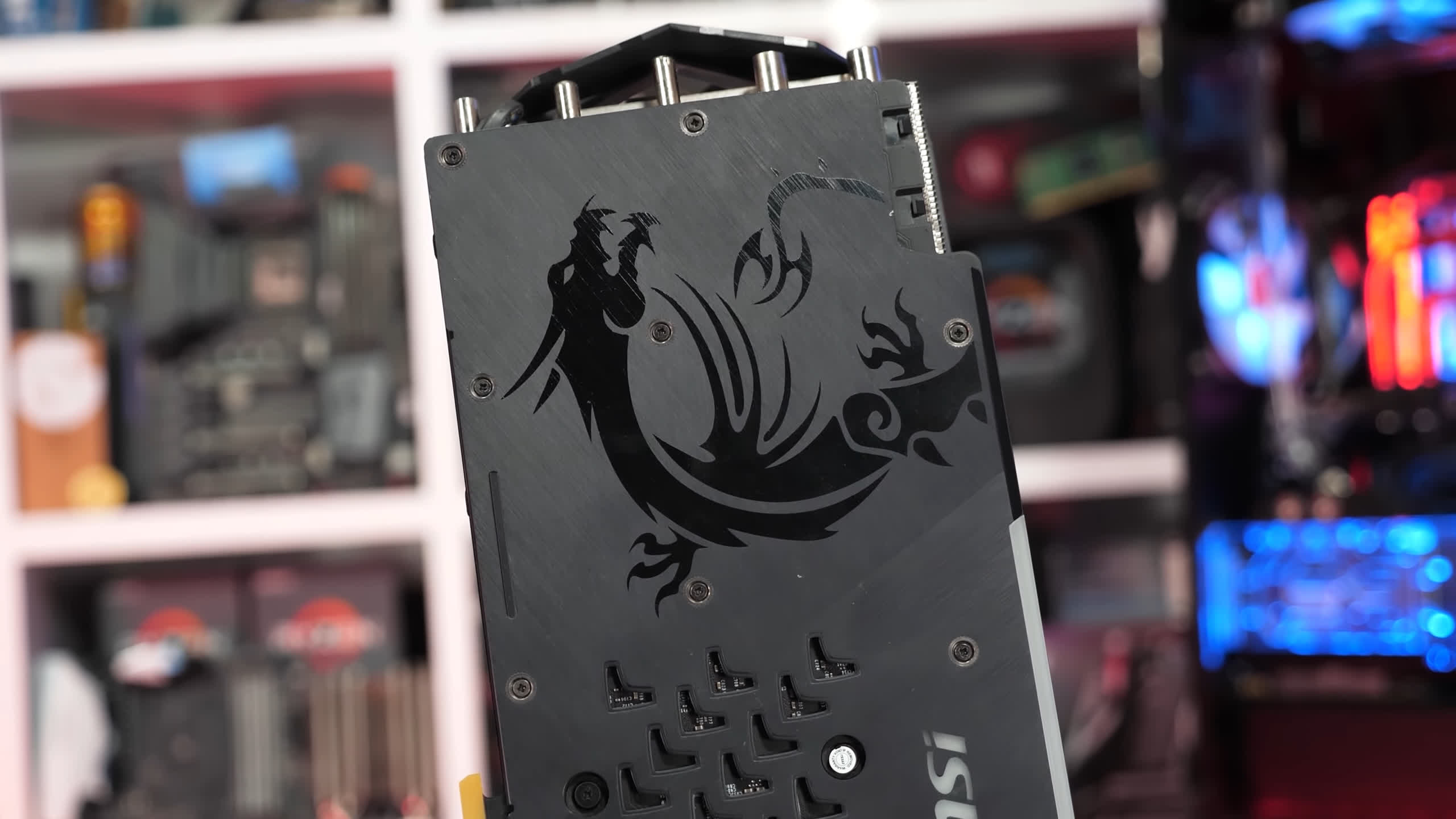Today we're taking a fresh look at the GeForce GTX 1080 Ti, because every time we do one of these GPU revisits, we get dozens of requests to check out the 1080 Ti, so here you go. Thankfully, I really enjoy looking at these previous generation GPUs, running them through a few dozen games to see how they're holding up.
As a quick refresher, Nvidia's GeForce GTX 1080 Ti was released back in early 2017 for $700 (see our original review), which at the time was considered an enormous amount of money for a gaming graphics card. Oh, how times have changed.
Despite the price tag though, the 1080 Ti still offered gamers impressive value, packing unrivaled performance and a fat 11GB VRAM buffer.
If we take a look at our most recent benchmark data used across our GPU reviews, including the GeForce RTX 3070 Ti, RTX 3080 Ti and Radeon 6600 XT, we see that the GTX 1080 Ti remains a capable gaming graphics card at 1440p, delivering 93 fps on average across the 12 games used for day one reviews.
That's 6% faster than the Radeon 5700 XT, but 18% slower than the 6700 XT. Then, when compared to current generation of so-called $700 parts, which would include the RTX 3080 and 6800 XT, the 1080 Ti is over 60% slower, but that's to be expected four years later.
That data was recorded using our Ryzen 9 5950X test system with 32GB of DDR4-3200 CL14 dual-rank, dual-channel memory. For this revisit we'll be using the same test system, but covering 31 games at 1080p, 1440p and 4K.
This is a follow up from the Radeon RX 5600 XT, 5700 XT and RTX 2060 Super testing that we recently posted.
We'll be using those GPUs for comparison and while it would have been nice to include a few more relevant parts such as the RTX 2070 Super and RTX 3080, for sake of time efficiency (it takes at least a few days to add a single GPU to this 31 game benchmark), we're posting these now with more to be added over the coming weeks.
Benchmarks
Let's now take a look at how these four GPUs compare in a dozen games before we check out the average gaming performance across all 31 tested titles, along with a few head to head comparisons.
We'll start with Biomutant which tends to favor GeForce GPUs. The game uses Unreal Engine 4 and it appears as though little optimization has been made for Radeons, as a result the 2060 Super and 5700 XT are comparable here and that means at 1440p the GTX 1080 Ti was a massive 28% faster, offering an entirely different tier of performance.

Whereas the 2060 Super and 5700 XT at times dipped below 60 fps, the 1080 Ti was good for well over 60 fps throughout our testing, so a great result for the old GeForce flagship.
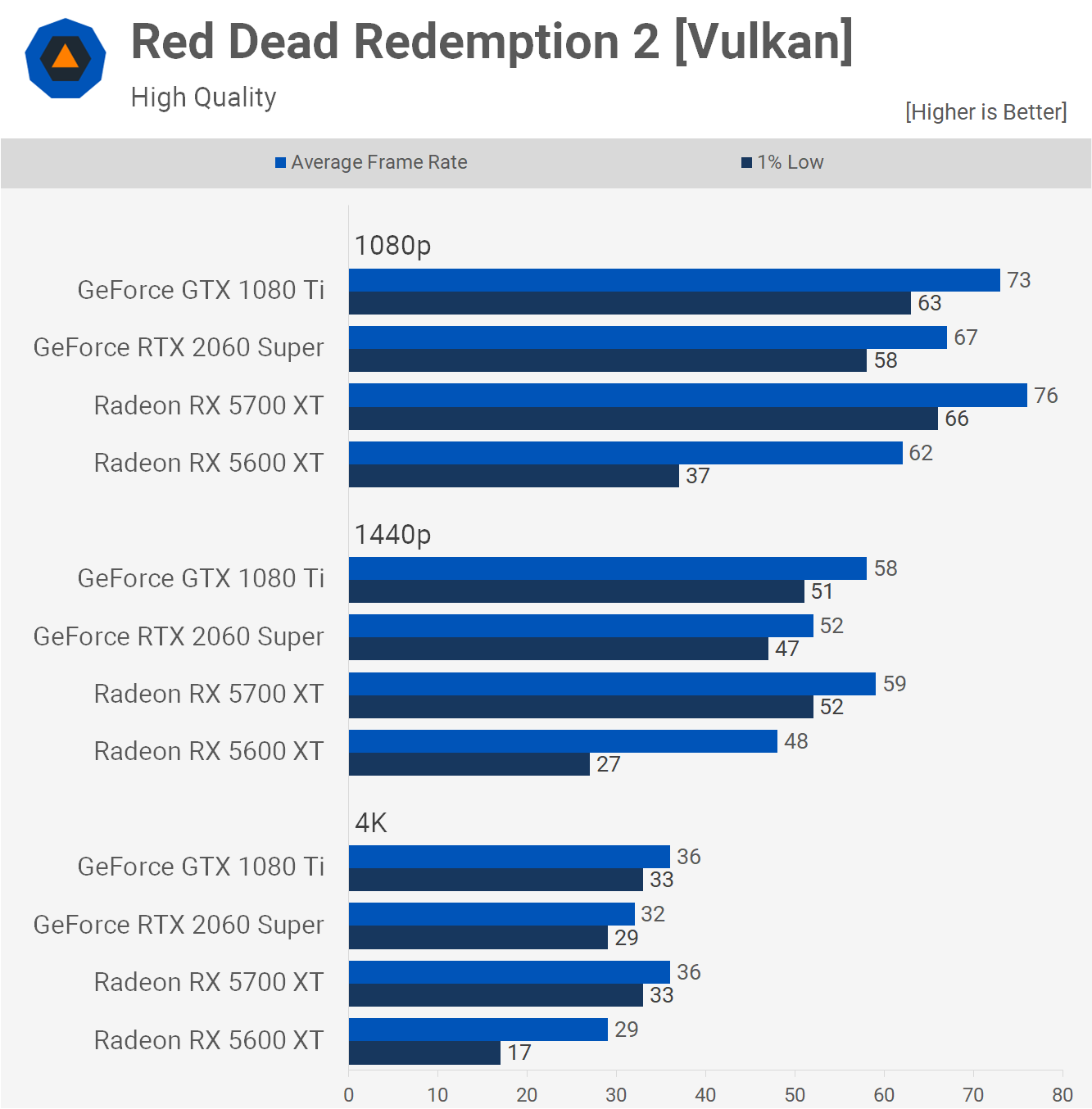
In Red Dead Redemption 2, the 5700 XT performed a lot better, matching the GTX 1080 Ti at all resolutions. Using the slightly dialed down 'high' settings the 1080 Ti struggled to deliver 60 fps at 1440p, and therefore is better suited to 1080p using these quality settings.
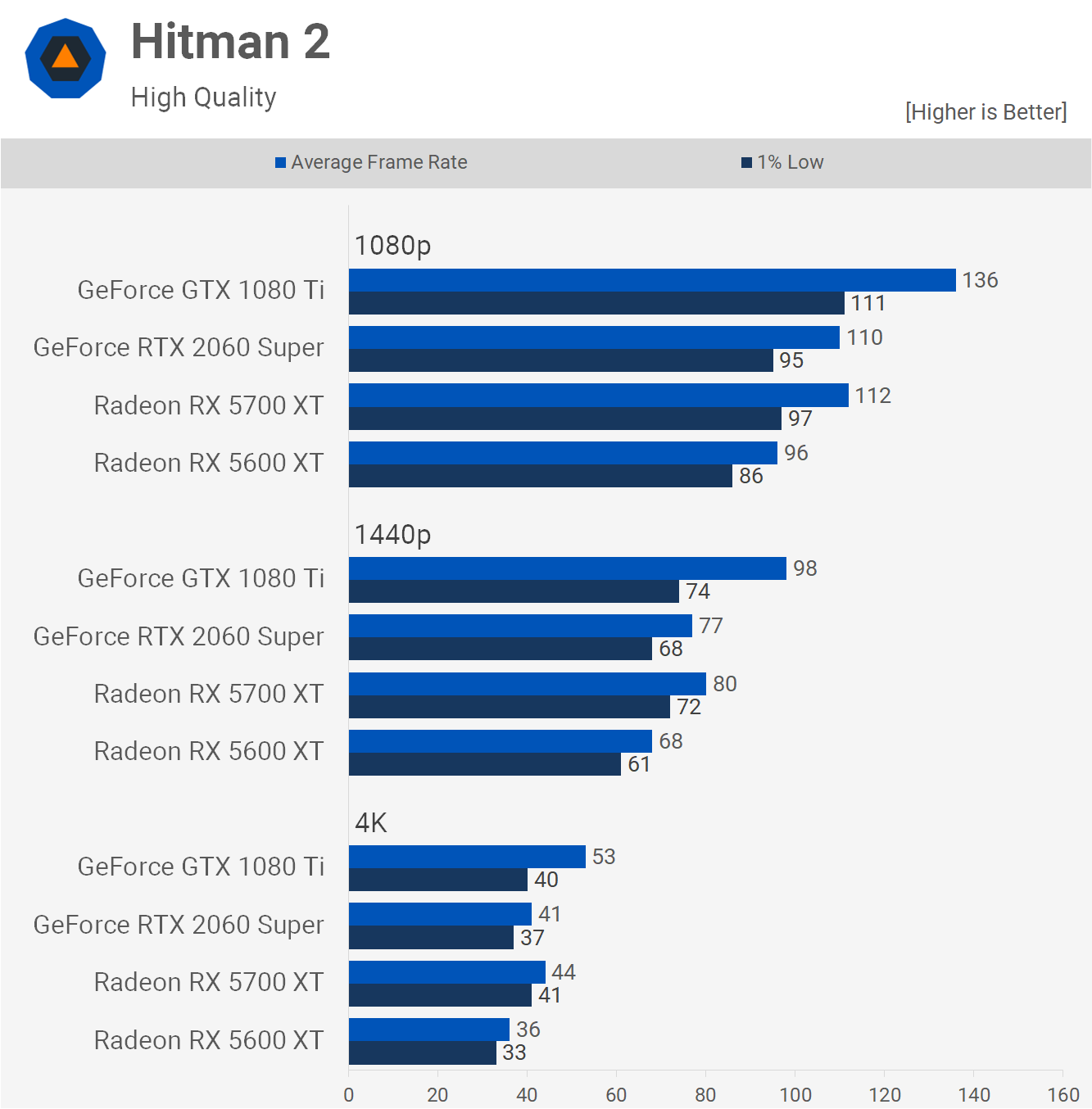
The GTX 1080 Ti was able to flex its muscle in Hitman 2, pumping out 98 fps at 1440p, making it 23% faster than the 5700 XT, and 27% faster than the 2060 Super. Similar margins were also seen at 1080p and 4K.
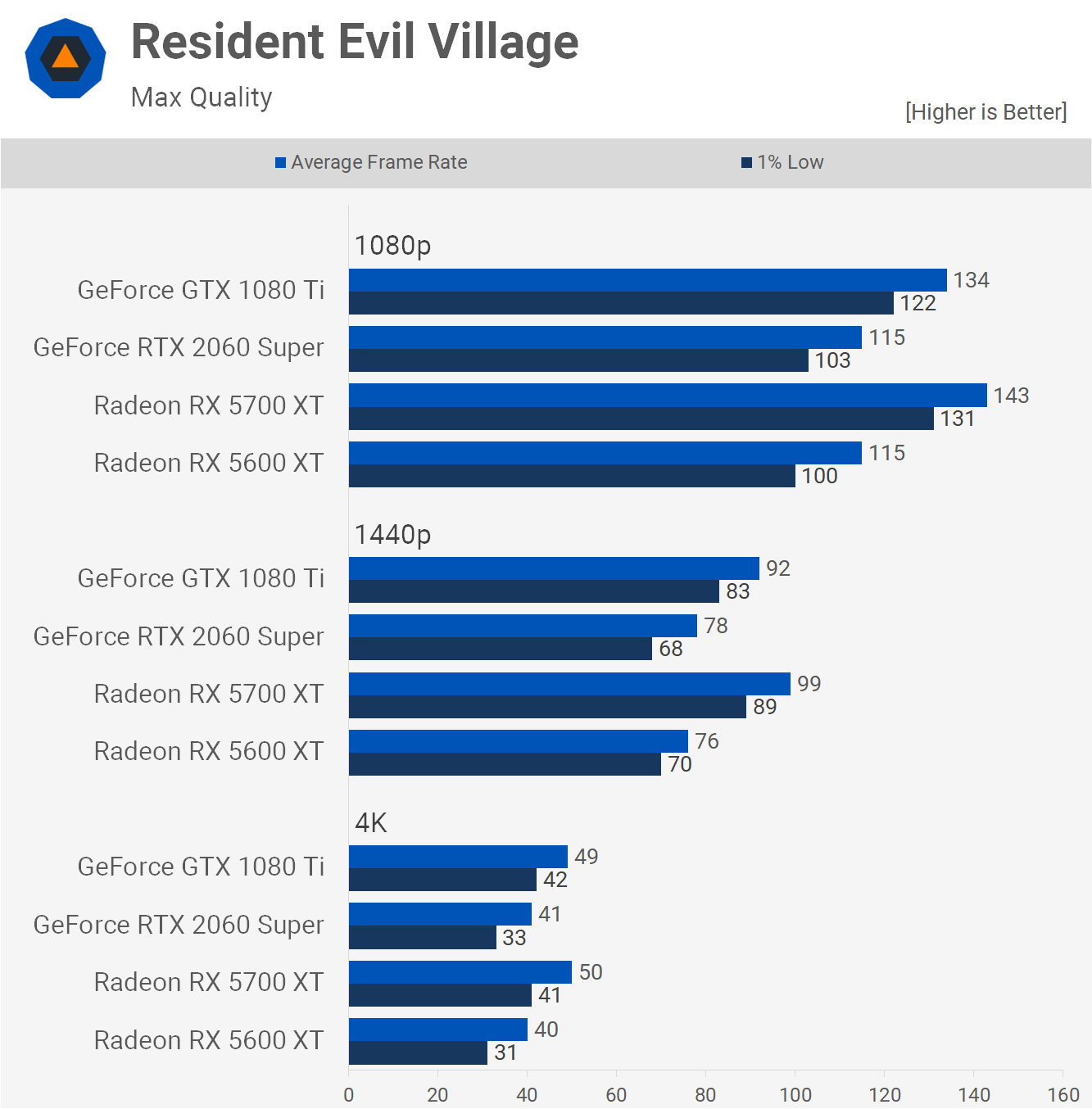
Resident Evil Village is a 2021 release and here the 5700 XT does get the better of the GTX 1080 Ti, delivering 7-8% greater performance at 1080p and 1440p. That said, the 1080 Ti was still very impressive, rendering over 80 fps at all times when testing at 1440p.
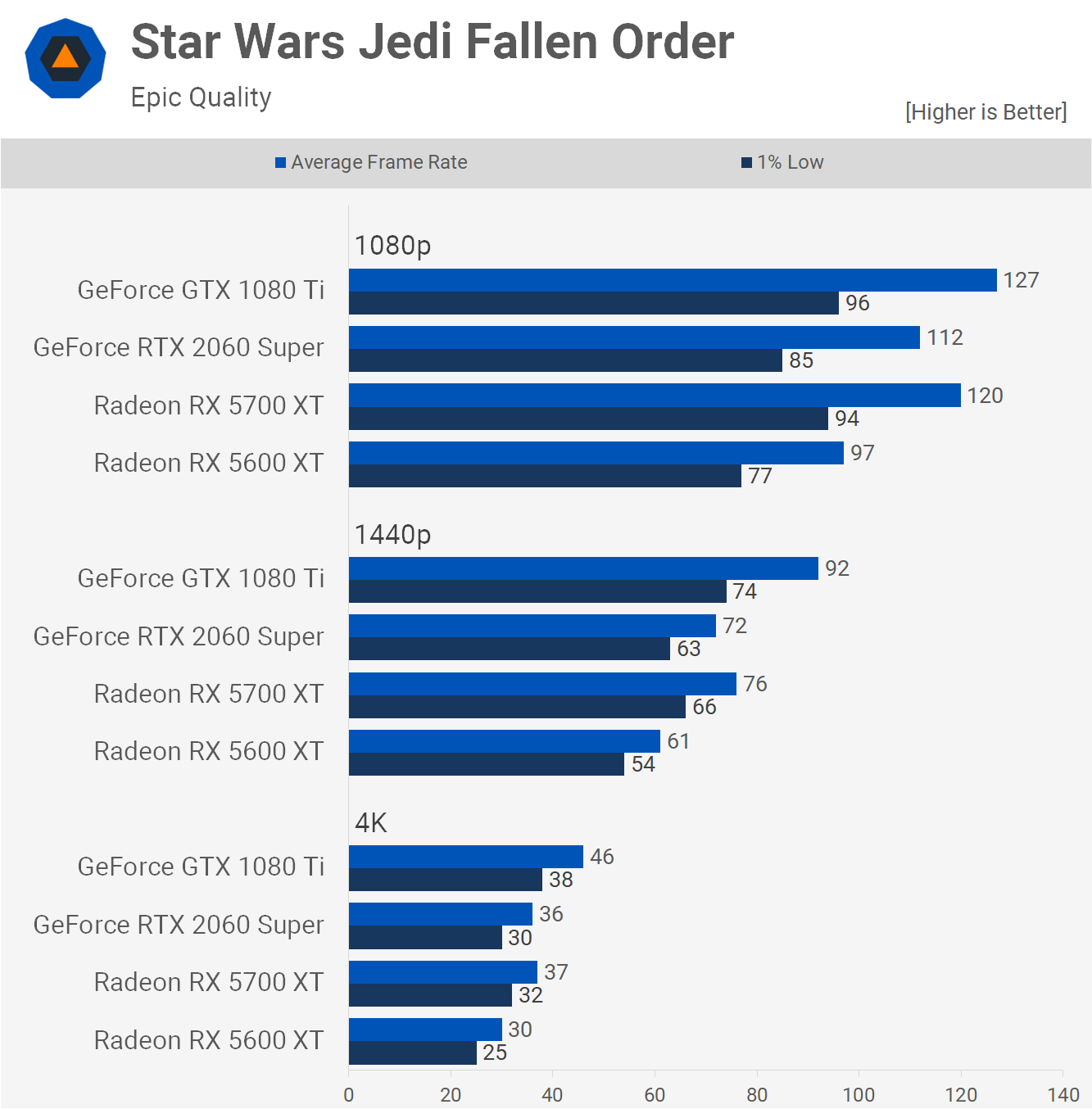
Star Wars Jedi Fallen Order is another Unreal Engine 4 title, though the Radeon GPUs do slightly better when compared to what we saw with Biomutant. Even so the GTX 1080 Ti was 6% faster than the 5700 XT and a massive 21% faster at 1440p.
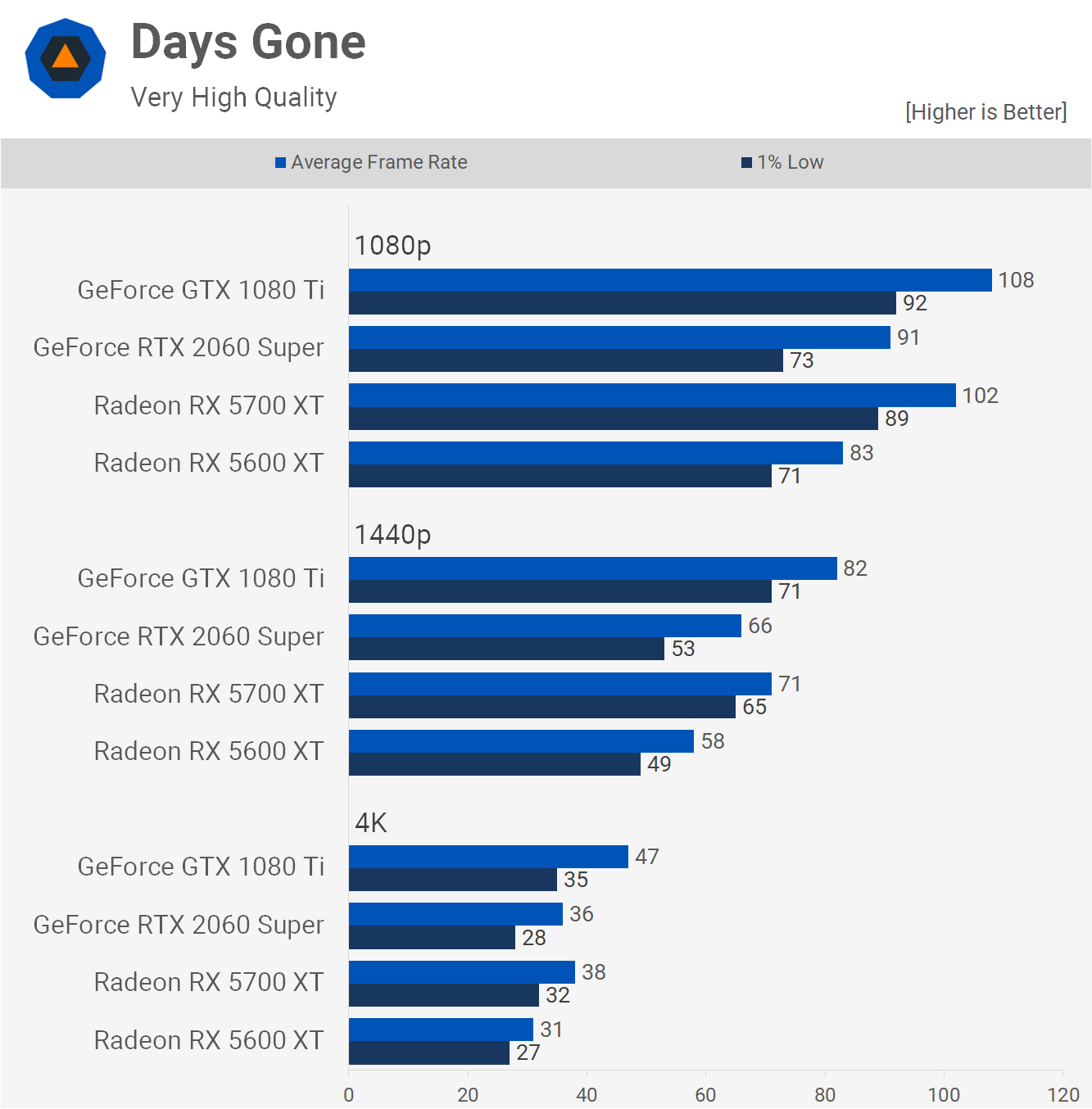
Days Gone also favors the GTX 1080 Ti and this is yet another Unreal Engine 4 title. Although the 5700 XT and GTX 1080 Ti were comparable at 1080p, the GeForce GPU runs away with it at 1440p, pulling ahead by a 15% margin with over 70 fps at all times in our testing.
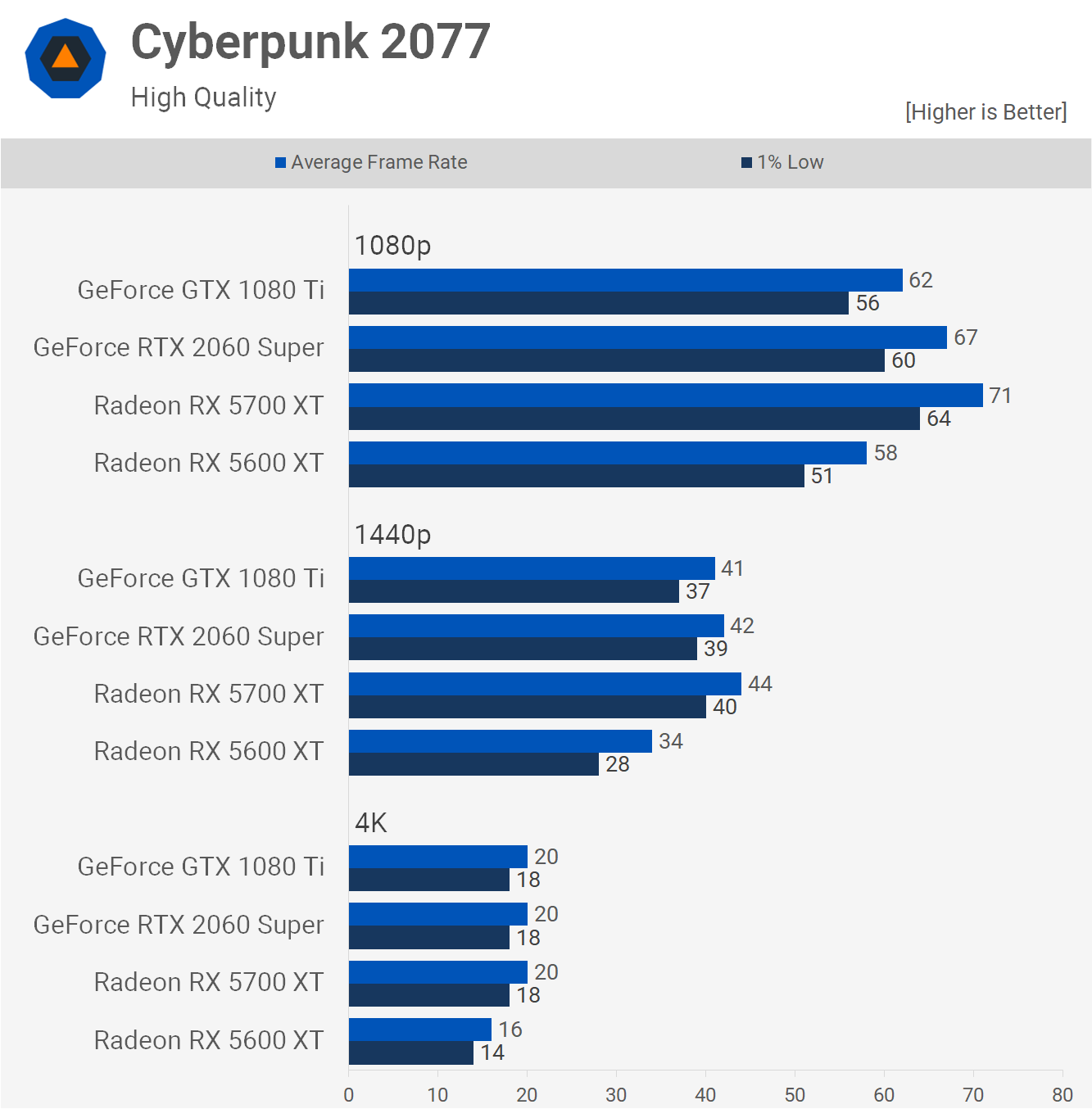
Next up we have Cyberpunk 2077, and please note we've updated our benchmark pass for this title, moving from a densely NPC populated area. Here these GPUs really struggled at 1440p and certainly weren't able to deliver a 60 fps experience, for that you'll need to drop down to 1080p, and please note we're not using the maxed out graphics either. Interestingly, the GTX 1080 Ti was slower than both the 2060 Super and 5700 XT, losing to the Radeon GPU by a 13% margin.
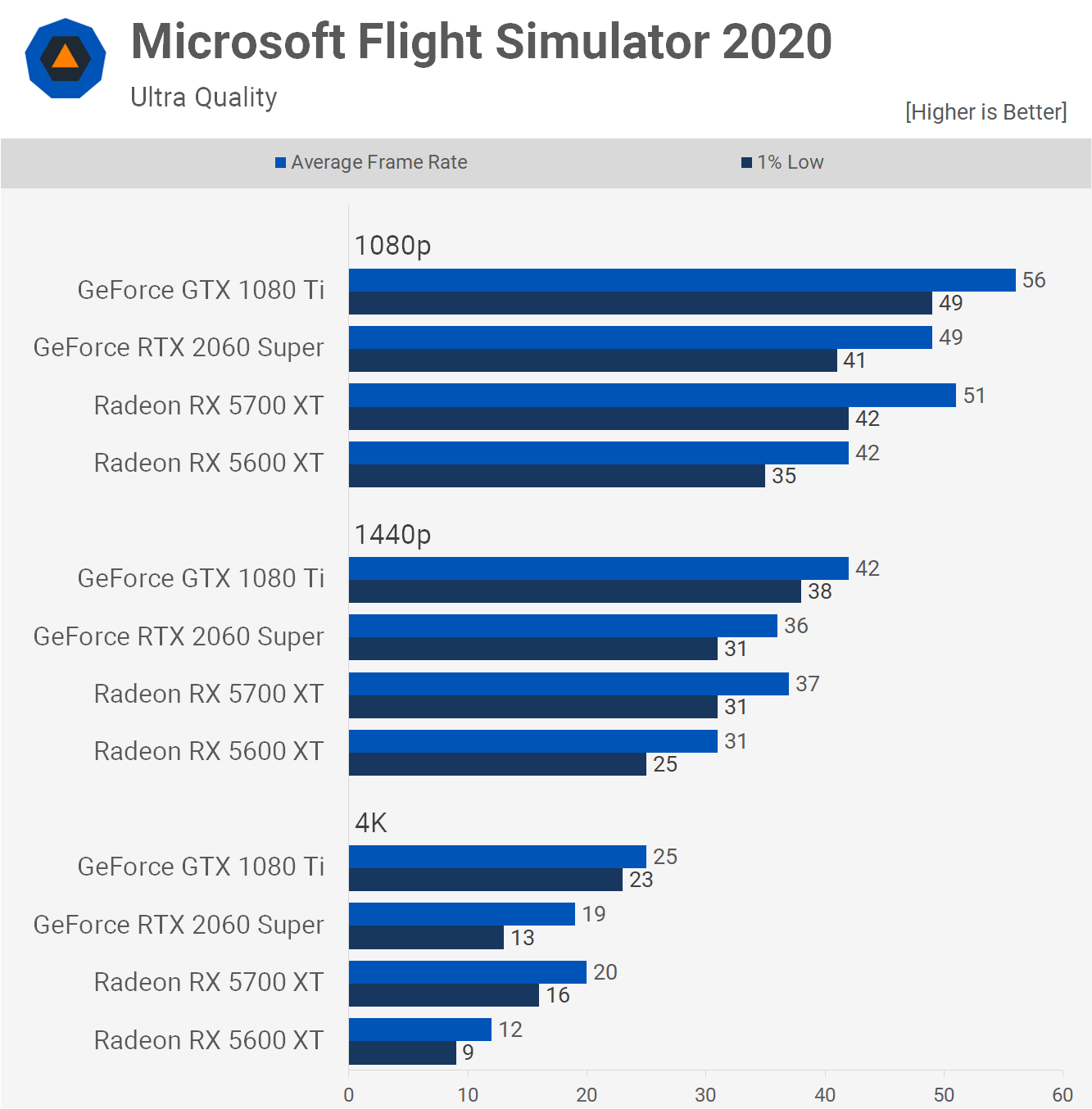
Moving on to Flight Simulator 2020, we've updated all our results for this title after a new patch improved performance across the board. The game's still not silky smooth on older hardware using the ultra quality preset, but we did see a big 30%+ improvement for all GPUs.
This allowed the 5600 XT to deliver playable performance at 1080p and now the 5700 XT is very smooth with 51 fps. That said, the GTX 1080 Ti was faster averaging 56 fps at 1080p, which is plenty for this simulator.

Shadow of the Tomb Raider is one of the older titles we're testing with, but it's still very demanding and looks quite good. The GTX 1080 Ti spat out 90 fps at 1440p, while the 5700 XT was good for 80 fps, making the GeForce GPU 13% faster.

F1 2021 is the newest game in this benchmark, and although it supports ray tracing and enables it by default on GPUs that support it, we've gone and disabled it on the RTX 2060 Super as it's the only RT enabled GPU here and rather than place it at a disadvantage we've simply disabled it for an apples to apples comparison.
The 5700 XT was 25% faster than the RTX 2060 Super at 1440p, and despite that huge margin, the GTX 1080 Ti was 6% faster than the 5700 XT. So a strong result for the Pascal GPU.
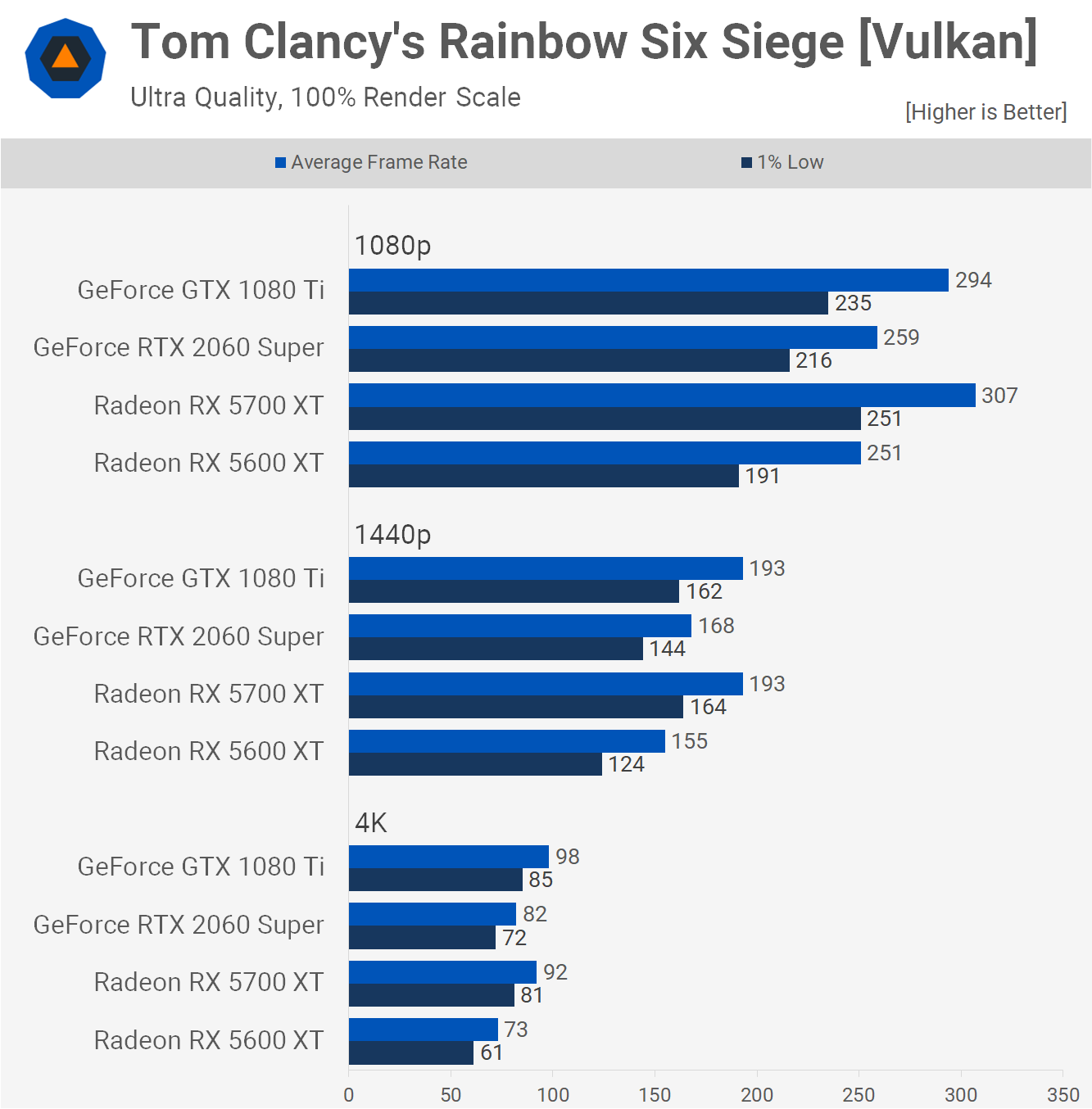
Unsurprisingly the GTX 1080 Ti powers through Rainbow Six Siege, delivering 193 fps on average at 1440p to match the 5700 XT, it's even capable of pushing up around 100 fps at 4K.
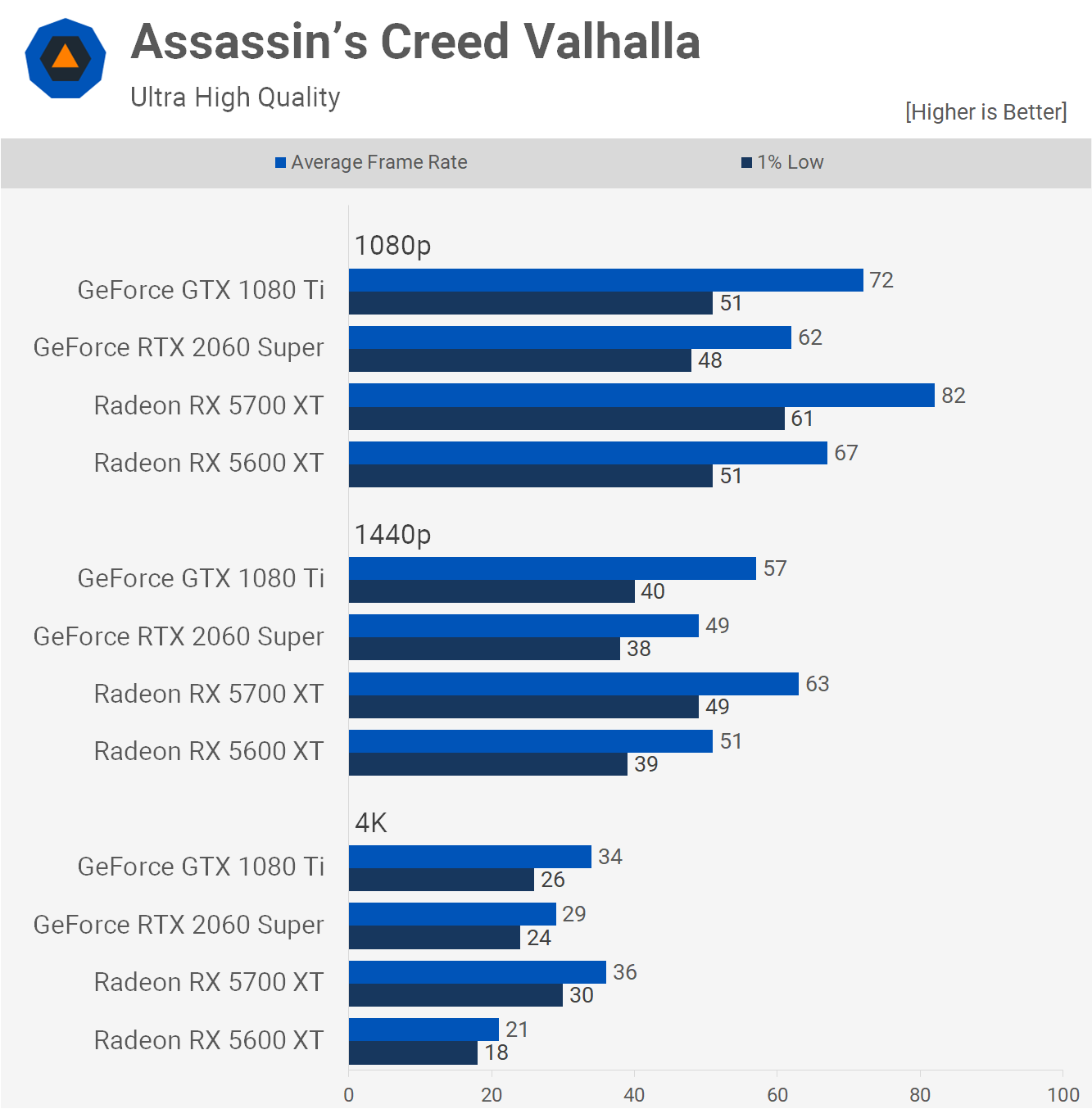
Finally, let's take a look at Assassin's Creed Valhalla which uses the AnvilNext 2.0 game engine and is well optimized for Radeon GPUs. The 5700 XT had no issue brushing aside the 1080 Ti, at least when looking at the 1080p and 1440p results where it was 14% and 11% faster respectively.
31 Game Average Performance
Here's a look at the average performance seen across the 31 games tested. The GTX 1080 Ti remains 6% faster than the 5700 XT at 1440p, which is the same margin seen in our smaller 12-game sample used for day-one reviews.
That means the GTX 1080 Ti is ~20% faster than the 2060 Super and with 100 fps on average, it's still a very competent 1440p gamer for the most part.
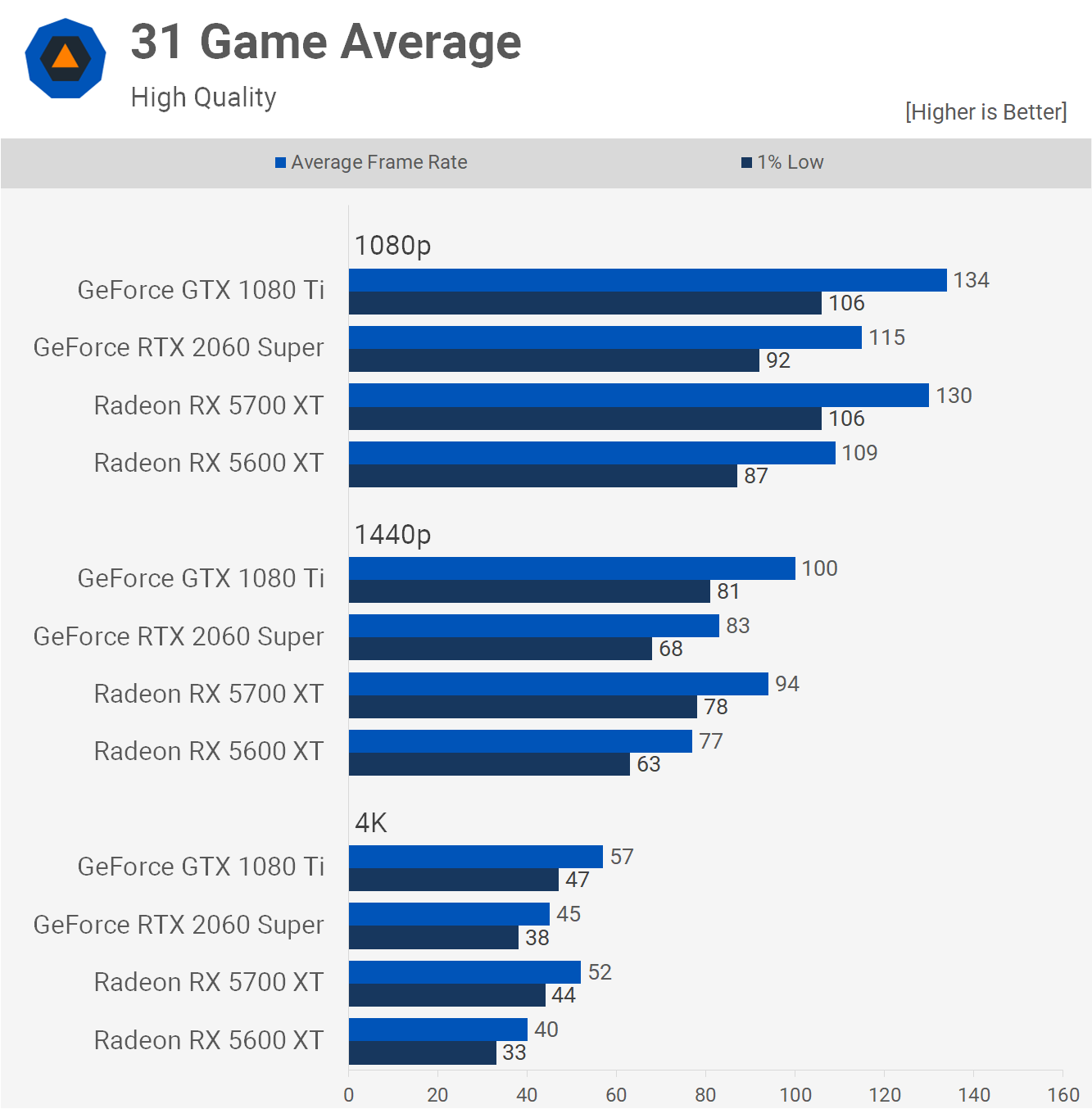
For those of you interested in how the 5700 XT and GTX 1080 Ti compare head-to-head in the games tested, well here's a look at just that.
The GeForce GPU is pushed ahead by massive wins in half a dozen of the games tested, those games include Valorant, PUBG, Biomutant, Hitman 2, Star Wars Jedi Fallen Order and Resident Evil 3.

Of those games, four use Unreal Engine 4 which isn't a surprise, and while it's possible for Radeon GPUs to perform quite well in UE games – take Borderlands 3 for example – it seems the developer really has to go out of their way to optimize for AMD hardware when using this popular engine, which continues to be a problem for Team Red.
If we look at the games where the 5700 XT does well and manages to beat the GTX 1080 Ti, you won't find any Unreal Engine 4 titles. Forza Horizon 4 uses the Forzatech engine, Assassin's Creed Valhalla uses the AnvilNext 2.0, Resident Evil Village the RE Engine, Cyberpunk 2077 REDengine 4, Doom Eternal id Tech 7, and Dota 2 the Source 2 engine.
What We Learned
In late 2021, the GeForce GTX 1080 Ti is hanging in really well. The GPU has aged well partly thanks to its large 11GB frame buffer, and will continue to be able to take advantage of HD texture packs for some time to come.
Talks about Nvidia abandoning older architectures and not optimizing newer games, at least for now that certainly hasn't been the case with Pascal, as the level of optimization for modern titles looks great.
The only issue with the GTX 1080 Ti today is the same issue faced by all GPUs: price and availability. The average selling price we've seen for the 1080 Ti over the past few months is around $600, which is just $100 less than the MSRP 4 years ago.
Basically you're looking at GeForce RTX 2070 money with the 2070 Super typically selling for around $50 more, though it's well worth that small premium given you pick up some really cool features such as DLSS.
That being the case, the GTX 1080 Ti makes no sense in 2021 to buy used. It's certainly miles better for gamers than the 5700 XT which is selling for ~$800, probably because that GPU is better for mining, so if you happen to have one, you will want to sell it and upgrade to a faster gaming card like the 6700 XT.
The GTX 1080 Ti has been an interesting GPU to track over the years, especially on the second hand market. Even during times when the market was flooded with discounted 5700 XT's and readily available 2070 Super's, the GTX 1080 Ti held its value well, never dipping below ~$400 at places like eBay.
For now we can only dream of $350 GTX 1080 Ti's, but if and when the market returns to more normal conditions, you can expect the flagship Pascal GPU to tumble in price on the second hand market.
For now the 6600 XT looks like your best shot at achieving GTX 1080 Ti-like performance, though pricing and availability still looks messy depending on where you live. In the US, you can pick one up on eBay for a little over $600. While in Australia we've been able to buy an RX 6600 XT graphics card for around $700 AUD, while GTX 1080 Ti typically sells for well over $800 AUD.
So as much as we disliked the 6600 XT in our day-one review, it's turning out to be the better available option for those seeking this level of gaming performance.



